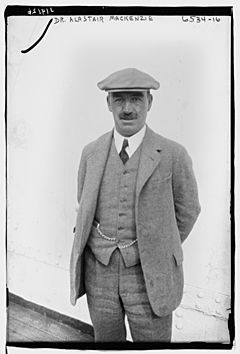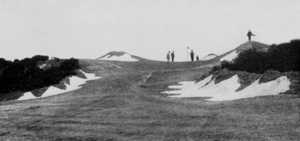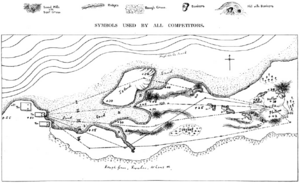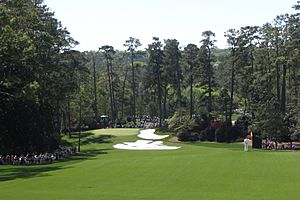Alister MacKenzie facts for kids
Quick facts for kids
Alister MacKenzie
|
|
|---|---|

Dr. Alister MacKenzie
|
|
| Born | 30 August 1870 Normanton, Yorkshire, England
|
| Died | 6 January 1934 (aged 63) |
| Nationality | British |
| Alma mater | Cambridge University |
| Occupation | Architect |
| Design |
|
Alister MacKenzie (born August 30, 1870 – died January 6, 1934) was a famous golf course architect. He designed golf courses all over the world!
Before becoming a golf architect, MacKenzie was trained as a surgeon. He even worked as a doctor for the British Army during the Boer War. It was during this war that he learned about camouflage. Later, during the First World War, MacKenzie used his knowledge to help with military camouflage. He believed that designing golf courses was a lot like designing camouflage.
MacKenzie is one of the most well-known golf architects ever. He is part of the World Golf Hall of Fame. He designed over 50 golf courses. Three of his designs are still ranked among the top 10 golf courses in the world today. These include Augusta National Golf Club and Cypress Point Club in the USA. Also, the Royal Melbourne Golf Club (West Course) in Australia is one of his designs.
Contents
Early Life and Learning
Alister MacKenzie was born on August 30, 1870. This was in Normanton, near Leeds in Yorkshire, England. His parents were from Scotland. His mother, Mary Jane Smith MacKenzie, had family in Glasgow. His father, William Scobie MacKenzie, was a doctor. He grew up in the Scottish Highlands.
Alister was named Alexander after his grandfather. But everyone called him "Alister," which is the Gaelic name for Alexander. When he was young, Alister and his family spent summers in Scotland. They visited lands that had belonged to his family, Clan MacKenzie, long ago. MacKenzie always felt a strong connection to his Scottish background.
He went to Queen Elizabeth Grammar School, Wakefield. Then he studied at Cambridge University. He first trained to be a medical doctor. He earned his first degree in 1891. He continued his medical studies, passing exams for the Royal College of Surgeons. In 1897, he earned his medical and surgery degrees from Cambridge.
Wartime Work
MacKenzie worked as a surgeon during the Second Boer War. He served with the Somerset Regiment in South Africa.
During this time, he became very interested in camouflage. The Boers used camouflage very well. When the First World War started, MacKenzie joined the army again. This time, he worked as a camoufleur, not a surgeon. He once gave a talk where he said the Boers' success was due to their great use of natural cover. He also noted how they built fake cover that looked real.
Designing Golf Courses
MacKenzie was a member of several golf clubs near Leeds. He joined them in the late 1890s. In 1907, he helped start the Alwoodley Golf Club. He was the club's secretary and later its captain. He also stayed on its green committee for many years.
Alwoodley was MacKenzie's first golf course design. It was his chance to test his ideas. The committee thought some of his ideas were too big. So, they asked Harry Colt for a second opinion. Colt was a top golf course architect. He visited Alwoodley and met MacKenzie. Colt realized MacKenzie's ideas were similar to his own. He supported MacKenzie's plans to the committee.
MacKenzie's modern ideas included wavy greens. He also designed long, narrow greens angled from the fairway. His bunkers were large and had natural shapes. He also added many hills and valleys to the courses. These features became his "signature style" throughout his career.
In 1914, MacKenzie won a golf hole design contest. It was held by Country Life magazine. This made him even more interested in golf course design. He studied the Old Course at St. Andrews in great detail. By 1915, he became a member of the R&A.
After the First World War, MacKenzie stopped being a doctor. He started working full-time as a golf course designer. In 1919, he joined Harry Colt and Charles Alison. They formed a company called Colt, MacKenzie & Alison. Four years later, MacKenzie started his own design business.
MacKenzie believed his camouflage work helped him design golf courses. In his first book, Golf Architecture (1920), he wrote about this. He said there was a "great likeness" between military camouflage and golf course building. He also wrote that a good golf architect must be artistic. They also need to understand science. He felt the main goal of a golf architect was to make their work look natural.
MacKenzie designed courses before big machines were used. His designs are known for fitting into the natural land.
Courses He Designed
|

A 1915 photo of the 2nd hole at Headingley Golf Club, designed by MacKenzie.
|
As a Golfer
MacKenzie himself said he was a "good putter" but not a great "ball striker" for most of his life. When he moved to California in his 60s, he had what he called his "golfing epiphany." This meant his ball striking got much better. He often scored in the high 70s or low 80s for 18 holes. He even wrote about this improvement in one of his books. MacKenzie was one of the first famous golf course designers who wasn't a top golf player.
His Lasting Impact
In the late 1920s, MacKenzie moved to the United States. There, he created some of his most famous golf courses. But he also kept designing courses in other countries. Today, he is remembered for designing some of the best courses in the world.
Some of his most famous designs include:
- Augusta National Golf Club in Augusta, Georgia
- Cypress Point Club on the Monterey Peninsula, California
- Royal Melbourne Golf Club in Melbourne, Australia
- Pasatiempo Golf Club in Santa Cruz, California
- Crystal Downs Country Club in Frankfort, Michigan
- Lahinch Golf Course in Lahinch, Ireland
- Meadow Club in Fairfax, California
Alister MacKenzie passed away in Santa Cruz, California, in January 1934. This was just two months before the very first Masters Tournament was held at Augusta National. After he died, an unfinished book he wrote about golf was found. It was later published as The Spirit of St. Andrews.




